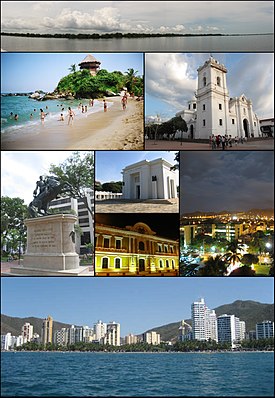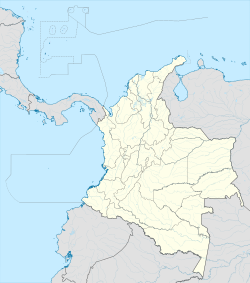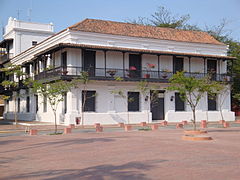world.wikisort.org - Colombia
Santa Marta (Spanish pronunciation: [ˌsanta ˈmaɾta]), officially Distrito Turístico, Cultural e Histórico de Santa Marta ("Touristic, Cultural and Historic District of Santa Marta"), is a city on the coast of the Caribbean Sea in northern Colombia. It is the capital of Magdalena Department and the fourth-largest urban city of the Caribbean Region of Colombia, after Barranquilla, Cartagena, and Soledad. Founded on July 29, 1525, by the Spanish conqueror Rodrigo de Bastidas, it was the first Spanish settlement in Colombia, its oldest surviving city, and second oldest in South America.[3] [citation needed] This city is situated on a bay by the same name and as such, it is a prime tourist destination in the Caribbean region.[4]
This article may be expanded with text translated from the corresponding article in Spanish. (December 2013) Click [show] for important translation instructions.
|
Santa Marta | |
|---|---|
City | |
 Top: Panorama of the Cienaga Grande de Santa Marta, 2nd left: Mirador in Cabo San Juan del Guia, Tayrona Natural Park, 2nd right: Santa Marta Cathedral, 3rd left: Statue of Simon Bolívar in Quinta of Saint Pedro Alejandrino, 3rd upper middle: Colombian National Pantheon in Barrio Mamatoco, 3rd lower middle: Santa Marta City Hall, 3rd right: Tribute to the Tayrona Ethnicity Square, Bottom: Panorama of Acuatico El Rodadero Park, from the Gaira area | |
 Flag  Coat of arms | |
| Nickname: America's Pearl (La Perla de America) | |
 Location in the Department of Magdalena. Municipality (dark grey) City (red) | |
 Santa Marta Location in Colombia | |
| Coordinates: 11°14′31″N 74°12′19″W | |
| Country | |
| Region | Caribbean Region |
| Department | Magdalena |
| Foundation | July 29, 1525 |
| Founded by | Rodrigo de Bastidas |
| Named for | Martha |
| Government | |
| • Mayor | Virna Johnson (2020–2023) (Fuerza Ciudadana) |
| Area | |
| • City | 2,393.65 km2 (924.07 sq mi) |
| • Urban | 55.10 km2 (21.27 sq mi) |
| Elevation | 6 m (20 ft) |
| Highest elevation [citation needed] | 5,775 m (18,947 ft) |
| Population (2018 Census[1]) | |
| • City | 499,192 |
| • Density | 210/km2 (540/sq mi) |
| • Urban | 455,299 |
| • Urban density | 8,300/km2 (21,000/sq mi) |
| DANE | |
| Demonym | Samario |
| Time zone | UTC-05:00 (Colombia Time) |
| Postal codes | 470001–470017[2] |
| Area code | 57 + 5 |
| Website | Official website (in Spanish) |
History
Pre-Colombian times
Before the arrival of Europeans, the South American continent was inhabited by a number of indigenous groups. Due to a combination of tropical weather, significant rainfall, and the destruction and misrepresentation of many records by Spanish conquistadors, our understanding of the peoples of this region is limited.
The Tairona formed mid- to large-size population centers, consisting of stone pathways, terraces, protected waterways, and spaces dedicated to agricultural produce. Their economy was primarily agricultural, cultivating corn, pineapple, yucca, and other local foodstuffs. The Tayrona are considered quite advanced for their time period. Surviving archaeological sites consisted of formed terraces and small scale underground stone channels. They also were known to actively collect and process salt, which was a significant trading commodity. We know that they traded with other indigenous groups along the coast and interior. Archaeological excavations have recovered significant works in pottery, stonework and gold.
Flag
Santa Marta's flag consists of two colors: white and blue. White symbolises peace, in that all are united without restriction. Blue symbolises the sky, the sea, the magic found in the horizon, and the snow-capped Sierra Nevada mountains.
Geography

Santa Marta is located on Santa Marta Bay of the Caribbean Sea in the province of Magdalena. It is 992 km from Bogotá and 93 km from Barranquilla. It is bordered to the north and west by the Caribbean and to the south by the municipalities of Aracataca and Ciénaga.
Climate
Santa Marta experiences a hot semi-arid climate (Köppen BSh) with largely uniform temperatures year round. The dry season lasts from December to April, while the wet season lasts from May to November.
| Climate data for Santa Marta (Simón Bolívar International Airport) 1981-2010 | |||||||||||||
|---|---|---|---|---|---|---|---|---|---|---|---|---|---|
| Month | Jan | Feb | Mar | Apr | May | Jun | Jul | Aug | Sep | Oct | Nov | Dec | Year |
| Record high °C (°F) | 37.0 (98.6) |
38.2 (100.8) |
37.0 (98.6) |
37.6 (99.7) |
37.4 (99.3) |
37.4 (99.3) |
37.8 (100.0) |
37.4 (99.3) |
37.2 (99.0) |
36.2 (97.2) |
38.2 (100.8) |
37.6 (99.7) |
38.2 (100.8) |
| Average high °C (°F) | 33.0 (91.4) |
33.6 (92.5) |
33.8 (92.8) |
33.6 (92.5) |
32.9 (91.2) |
33.0 (91.4) |
33.0 (91.4) |
32.8 (91.0) |
32.5 (90.5) |
32.1 (89.8) |
32.1 (89.8) |
32.4 (90.3) |
32.9 (91.2) |
| Daily mean °C (°F) | 27.4 (81.3) |
27.9 (82.2) |
28.4 (83.1) |
28.9 (84.0) |
29.1 (84.4) |
29.1 (84.4) |
28.8 (83.8) |
28.6 (83.5) |
28.3 (82.9) |
27.9 (82.2) |
27.8 (82.0) |
27.5 (81.5) |
28.3 (82.9) |
| Average low °C (°F) | 22.3 (72.1) |
23.2 (73.8) |
24.2 (75.6) |
25.3 (77.5) |
25.5 (77.9) |
25.1 (77.2) |
24.6 (76.3) |
24.5 (76.1) |
24.3 (75.7) |
24.2 (75.6) |
23.8 (74.8) |
22.7 (72.9) |
24.1 (75.4) |
| Record low °C (°F) | 17.4 (63.3) |
18.3 (64.9) |
20.0 (68.0) |
19.0 (66.2) |
18.0 (64.4) |
19.0 (66.2) |
18.0 (64.4) |
18.0 (64.4) |
17.0 (62.6) |
17.0 (62.6) |
17.0 (62.6) |
18.0 (64.4) |
17.0 (62.6) |
| Average rainfall mm (inches) | 3.1 (0.12) |
2.0 (0.08) |
2.3 (0.09) |
14.1 (0.56) |
55.4 (2.18) |
60.7 (2.39) |
59.6 (2.35) |
70.0 (2.76) |
88.3 (3.48) |
111.0 (4.37) |
63.5 (2.50) |
15.2 (0.60) |
545.3 (21.47) |
| Average rainy days | 0 | 1 | 1 | 3 | 7 | 9 | 10 | 13 | 13 | 13 | 8 | 2 | 80 |
| Average relative humidity (%) | 74 | 72 | 72 | 74 | 76 | 76 | 77 | 78 | 79 | 80 | 79 | 76 | 76 |
| Mean monthly sunshine hours | 285.2 | 248.6 | 251.1 | 228.0 | 223.2 | 228.0 | 232.5 | 220.1 | 201.0 | 204.6 | 219.0 | 269.7 | 2,811 |
| Mean daily sunshine hours | 9.2 | 8.8 | 8.1 | 7.6 | 7.2 | 7.6 | 7.5 | 7.1 | 6.7 | 6.6 | 7.3 | 8.7 | 7.7 |
| Source: Instituto de Hidrologia Meteorologia y Estudios Ambientales[5][6][7] | |||||||||||||
Economy
Santa Marta's economy is based on tourism, trade, port activities, fishing and agriculture, in that order.[citation needed] The main agricultural products are: bananas, coffee, cocoa and cassava.[citation needed]
Infrastructure
Santa Marta is a major port. Simon Bolivar International Airport (IATA: SMR ) is 16 km (10 mi) from the city centre. Historic figure Simon Bolivar died here, a significant event for South America as a whole. His villa known as La Quinta de San Pedro Alejandrino is located just outside the city centre. As the main city centre is located close to the coast, the city itself has had difficulty controlling expansion. Although, technically a separate locality, Rodadero is part of Santa Marta itself.
Gallery
- Quinta de San Pedro Alejandrino in Santa Marta
- Casa de la Aduana y Alcapulca
- Statue of Rodrigo de Bastidas
- Rodadero, Santa Marta
- Rodadero aquarium
- Traditional house in Santa Marta
- Lighthouse in the bay of Santa Marta
- El Morro island off the coast of Santa Marta
- Harbour of Santa Marta
- Tayrona National Natural Park
- The cathedral (inner view)
- On central square
- The cathedral
Notable people
- Carlos Vives, singer of vallenato music
- Radamel Falcao, professional footballer
- Taliana Vargas, actress and model
- Alejandro Palacio, singer of vallenato music
- Sergio Díaz-Granados Guida, IDB Executive Director for Colombia and Peru
- Maria Claudia Lacouture, executive director of the Colombo American Chamber of Commerce
- Carlos Valderrama, professional footballer
- Andrés Solano, professional footballer
- Johan Vonlanthen, professional footballer
- Arturo Reyes, football coach
- Inés María Zabaraín, journalist
Media appearances
Santa Marta is the production location of the TV series The White Slave.
See also
- Taganga
- Ciudad Perdida
- Tayrona National Natural Park
References
- https://www.dane.gov.co/files/varios/informacion-capital-DANE-2019.pdf [bare URL PDF]
- "Santa Marta Postal Codes". Retrieved 2017-08-31.
- "Santa Marta historia y tradición" (in Spanish). Ministerio de Educación Nacional.
- "Colombia" (in Spanish). Decameron. Archived from the original on 26 February 2009. Retrieved 28 May 2009.
- "Promedios Climatológicos 1981–2010" (in Spanish). Instituto de Hidrologia Meteorologia y Estudios Ambientales. Archived from the original on 15 August 2016. Retrieved 16 August 2016.
- "Promedios Climatológicos 1971–2000" (in Spanish). Instituto de Hidrologia Meteorologia y Estudios Ambientales. Archived from the original on 15 August 2016. Retrieved 16 August 2016.
- "Tiempo y Clima" (in Spanish). Instituto de Hidrologia Meteorologia y Estudios Ambientales. Archived from the original on 15 August 2016. Retrieved 16 August 2016.
External links
- (in Spanish) UNIMAGDALENA
- (in Spanish) Bank of the Republic, economic history of Santa Marta
 Media related to Santa Marta at Wikimedia Commons
Media related to Santa Marta at Wikimedia Commons Santa Marta travel guide from Wikivoyage
Santa Marta travel guide from Wikivoyage- . New International Encyclopedia. 1905.
На других языках
- [en] Santa Marta
[ru] Санта-Марта
Санта-Марта (исп. Santa Marta) — город и муниципалитет на севере Колумбии на побережье Карибского моря рядом с горами Сьерра-Невада. Столица департамента Магдалена. Город Санта-Марта является важным морским портом, историческим, культурным и туристическим центром. Население по состоянию на 2005 год составляло 415 270 человек, площадь города равна 2393,35 км², а плотность — 173,5 чел./км².Другой контент может иметь иную лицензию. Перед использованием материалов сайта WikiSort.org внимательно изучите правила лицензирования конкретных элементов наполнения сайта.
WikiSort.org - проект по пересортировке и дополнению контента Википедии












